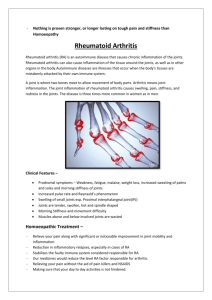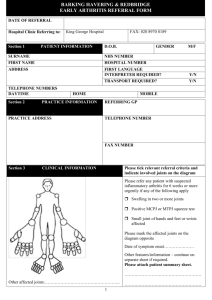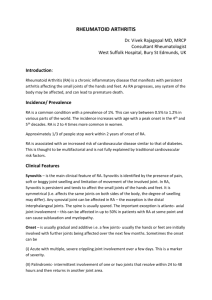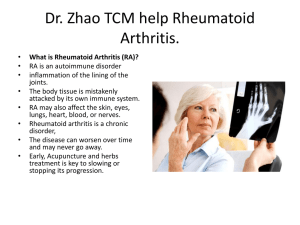Management of polyarticular joint pain
advertisement
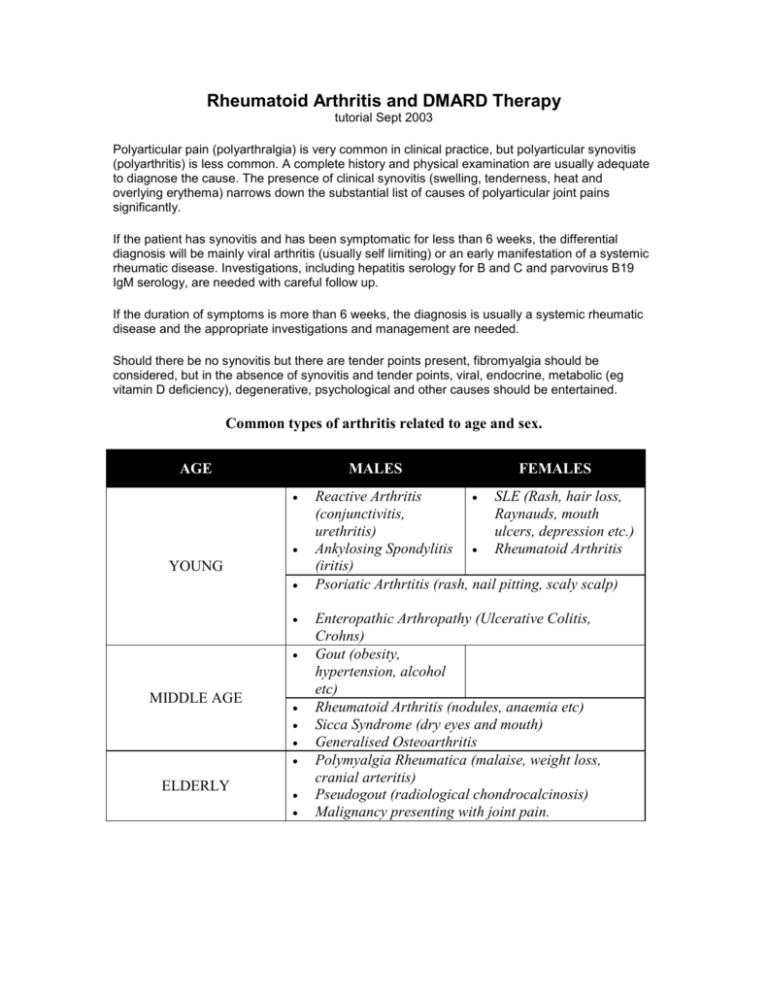
Rheumatoid Arthritis and DMARD Therapy tutorial Sept 2003 Polyarticular pain (polyarthralgia) is very common in clinical practice, but polyarticular synovitis (polyarthritis) is less common. A complete history and physical examination are usually adequate to diagnose the cause. The presence of clinical synovitis (swelling, tenderness, heat and overlying erythema) narrows down the substantial list of causes of polyarticular joint pains significantly. If the patient has synovitis and has been symptomatic for less than 6 weeks, the differential diagnosis will be mainly viral arthritis (usually self limiting) or an early manifestation of a systemic rheumatic disease. Investigations, including hepatitis serology for B and C and parvovirus B19 IgM serology, are needed with careful follow up. If the duration of symptoms is more than 6 weeks, the diagnosis is usually a systemic rheumatic disease and the appropriate investigations and management are needed. Should there be no synovitis but there are tender points present, fibromyalgia should be considered, but in the absence of synovitis and tender points, viral, endocrine, metabolic (eg vitamin D deficiency), degenerative, psychological and other causes should be entertained. Common types of arthritis related to age and sex. AGE MALES YOUNG MIDDLE AGE ELDERLY FEMALES Reactive Arthritis SLE (Rash, hair loss, (conjunctivitis, Raynauds, mouth urethritis) ulcers, depression etc.) Ankylosing Spondylitis Rheumatoid Arthritis (iritis) Psoriatic Arthrtitis (rash, nail pitting, scaly scalp) Enteropathic Arthropathy (Ulcerative Colitis, Crohns) Gout (obesity, hypertension, alcohol etc) Rheumatoid Arthritis (nodules, anaemia etc) Sicca Syndrome (dry eyes and mouth) Generalised Osteoarthritis Polymyalgia Rheumatica (malaise, weight loss, cranial arteritis) Pseudogout (radiological chondrocalcinosis) Malignancy presenting with joint pain. Rheumatoid arthritis – is a common inflammatory arthritis affecting 0.5% to 1% of the population (more than 350,000 people in Britain). It has a large economic impact because about 90% of patients have some form of disability within two decades. It costs the NHS on average £3,500 per patient per year. It is a very variable disease; the number and type of joints involved is different in individual patients and the severity and duration of the inflammation also varies. It is the one rheumatic disease most associated with severe physical handicap and is three times more common amongst females than amongst males. RA causes inflammation of the lining membrane of the joint (synovium). This results in more swelling and other signs of inflammation than is usual in osteoarthritis and can lead to severe damage of the joints. Diagnostic Criterion for RA. 1. Morning stiffness 2. 3. 4. 5. 6. 7. Morning stiffness in and around the joints, lasting at least 1 h before maximal improvement Arthritis of 3 or more joint areas At least 3 joint areas (out of 14 possible areas; right or left proximal interphalangeal, metacarpophalangeal, wrist, elbow, ankle, metatarsophalangeal joints); simultaneously have had soft tissue swelling or fluid (not bony overgrowth alone) as observed by a physician Arthritis of hand joints At least 1 area swollen (as defined above) in a wrist, metacarpophalangeal, or proximal interphalangeal joint Symmetric arthritis Simultaneous involvement of the same joint areas (as defined in criterion 2) on both sides of the body (bilateral involvement of proximal interphalangeals, metacarpophalangeals, or metatarsophalangeals, without absolute symmetry is acceptable) Rheumatoid nodules Subcutaneous nodules over bony prominences or extensor surfaces, or in juxtaarticular regions as observed by a physician Serum Rheumatoid Factor Demonstration of abnormal amounts of serum rheumatoid factor by any method for which the result has been positive in less than 5% of normal control subjects Radiographic Changes Radiographic changes typical of rheumatoid arthritis on posteroanterior hand and wrist radiographs, which must include erosions or unequivocal bony decalcification localized in, or most marked adjacent to, the involved joints (osteoarthritis changes alone do not qualify) Making a diagnosis Complete history and clinical examination/assessment of symptoms: o morning stiffness, fatigue o synovitis of three or more joint areas o symmetric arthritis Remember: o the pattern of joint involvement almost always favours the MCP and PIP joints/wrists o the swelling on palpation is characteristic. Synovial swelling is soft unlike the hard, bony swelling in diseases like osteoarthritis Differential diagnosis o o o o other inflammatory arthritis, e.g. post viral non-inflammatory joint conditions connective tissue diseases other important diagnoses, e.g. polymyalgic rheumatica Investigations: o full blood count (FBC) o Erythrocyte sedimentation rate (ESR)/C-reactive protein (CRP) o rheumatoid factor (RF) o X-ray hands/feet (not necessary before referral) Early RA – treatment Treatment of RA begins as soon as the diagnosis is made and lasts the patient's lifetime Explanation, education and support are constantly needed and are vital to treatment success Specific physical interventions ranging from splints to surgery will be needed throughout the course of the disease Drug therapy will be almost universal; there will be a need for clear explanation of drug effects and side-effects The window of opportunity for effective drug therapy is small, and early suppressive treatment is a vital contributor to success Drug treatment has two functions: o symptom relief (pain being the major symptom, followed by stiffness) o modification of destructive progression of the disease Analgesics are poor treatment by themselves, but are useful adjuncts to nonsteroidal anti-inflammatory drugs (NSAIDs) and disease modifying therapy Preparations will vary from paracetamol to its combination with codeine, dihydrocodeine or dextropropoxyphene. Choice is individual and none has any intrinsic merit compared with others, although in practice co-proxamol is the analgesic taken most frequently by RA patients NSAIDs They reduce pain and stiffness in patients with RA, but have no effect on disease progression All have side-effects, the most important being gut irritation and bleeding As symptomatic remedies they are better than plain analgesics in inflammatory conditions General issues Nonsteroidal anti-inflammatory drugs (NSAIDs) relieve symptoms of pain, stiffness, and swelling in rheumatoid arthritis (RA) [SIGN, 2000]. They are not disease modifying. Gastrointestinal (GI) toxicity is a particular concern with NSAIDs. It is estimated that a serious GI complication occurs in 13 out of every 1000 people with RA who take NSAIDs for a year [SIGN, 2000]. Risk factors for NSAID-induced ulceration include: o Age of 65 years and over o Previous clinical history of gastroduodenal ulcer, GI bleeding, or gastroduodenal perforation o Concomitant use of medications that are known to increase the likelihood of upper GI adverse events, for example corticosteroids and anticoagulants o Presence of serious comorbidity, such as cardiovascular disease, renal or hepatic impairment, diabetes, and hypertension o Requirement for the prolonged use of maximum recommended doses of standard NSAIDs [NICE, 2001] Hormone replacement therapy Recommended in RA for two reasons: It improves the control of arthritis It is the best preventative treatment for osteoporosis, a particular risk in RA Disease-modifying drugs There is no doubt that these drugs improve disease symptom control, and little doubt that they do retard the progress of erosive destruction of joints Synovitis is the major sign of RA; if this is not controlled by NSAIDs then diseasemodifying drugs must be introduced In order to be of maximum effectiveness, they must be introduced early in the course of the disease and continued for as long as possible Traditionally, initiation of disease-modifying drug therapy is the province of the hospital therapist, but increasingly GPs have been willing to initiate treatment There are some essential guidelines for GPs who do initiate such therapy: o they must be confident in clinical rheumatological diagnosis o they must have in place effective monitoring systems o they must be willing to deal with both minor and major drug side effects o their practice must have an effective educational and support system for RA patients Even if all these criteria are met, most GPs will ask for an assessment by the specialist hospital team as soon as possible after diagnosing RA, and will wish for ongoing care of patients to be shared with the hospital team Disease-modifying drugs currently in use: o enteric-coated sulfasalazine o o o o o o hydroxychloroquine auranofin myocrisin D-penicillamine azathioprine methotrexate An individual patient may move through all of these drugs, singly and in combination, during the course of the disease There is no 'right answer' as to which drug is first choice, although enteric-coated sulfasalazine and methotrexate are the most commonly prescribed. The most important point for a GP starting a patient on a disease-modifying drug to consider is that the practice is sufficiently well organised to carry out a full monitoring and supervision programme and sufficiently experienced to deal with drug and disease problems The decision to stop a disease-modifying drug should only be taken with the same degree of care and consideration as the initial decision to start it Which is the best DMARD? From Bandolier: “Clinical bottom line: We consider two systematic reviews here: Based on Capell et al, there does not appear to be any difference in the efficacy of gold, penicillamine, sulphasalazine or auranofin in the treatment of rheumatoid arthritis over a 12 month period. The Felson et al review considered more drugs, had a more comprehensive search strategy, with a larger dataset, but no pain outcome. Based on this review, in an efficacy/toxicity trade-off, methotrexate and antimalarial drugs had the highest efficacy relative to toxicity. Sulphasalazine also performed well, although was slightly more toxic. The least desirable drugs were intra-articular gold and auranofin.” DRUG DOSE Sulphasalazine Oral 500mg/day increasing by 500mg each week to a maximum of 2-3 g/day Methotrexate Oral 7.5mg/week increasing by 2.5 mg every 6 weeks to 1520mg/week if needed. Use lower doses if frail, elderly or if there is renal impairment. Consider adding folic acid 5mg, 3 days after each dose to reduce toxicity. Avoid concomitant clotrimoxazole therapy. Side Effects Monitoring Requirements Nausea, rash, neutropenia, low sperm count (reversible) FBC and LFT’s start, then FBC 2 weekly and LFT’s 4 weekly for 12 weeks, then 3 monthly for a year then 6 monthly. Alopecia, rash, nausea, gastro-intestinal upset, particularly diarrhea, hepatic fibrosis, acute fibrosing alveolitis, leucopenia, mouth ulcers At baseline FBC u and e’s LFT’s CXR.. FBC weekly until 6 weeks after last dose increase then monthly. LFT’s should be checked 2-4 monthly and u and e’s monthly (however, many rheumatologists suggest checking LFT’s monthly). Leflunomide Oral administration. Loading dose- 100mg once daily for 3 days. Maintenance dose10mg to 20mg once daily. Diarrhoea, rash, hair loss, hypertension, nausea, elevated liver enzymes Hydroxychloroquine Orally 200mg bd for 3-4 months then 200mg every day. Rash GI upset, retinal toxicity. FBC incl. differential white cell count and platelets, before treatment and then every 2 weeks for the first 6 months and every 8 weeks thereafter. ALT before treatment , monthly or more frequently for the first 6 months and every 8 weeks thereafter. Blood pressure- before treatment and periodically thereafter. Requires baseline ophthalmological assessment and 6-12 monthly thereafter (however many rheumatologists feel that baseline visual assessments with an annual follow up by an optician is all that is required. Penicillamine Orally 125mg/day for 4 weeks increasing by 125mg (min 4 weekly) to 500mg/day after 6 months. Can then be increased by 125mg to 750mg/day after 36 weeks then by 125mg every 4 weeks to 1g/day Rash, nausea, loss of taste, proteinuria, pancytopenia, myasthenia At baseline FBC, U and E’s,urinalysis. Urinalysis and FBC every 1-2 weeks until on a stable dose, then monthly checks. Advisable to check FBC 1 week after a dose increase. Sodium Aurothiomalate Intramuscularly 10mg test dose then 50mg/week. Dose interval increasing with response to drug up to a dose of 1g. Rash, mouth ulceration, proteinuria, pancytopenia, nephrotoxicity. FBC and urinalysis at baseline and before each injection. Complementary therapy This must never be used in place of disease-modifying medication, but always in addition to it. Therapies may include: o relaxation o diets o food supplements o food allergy o acupuncture o manipulation The most important things offered by most complementary therapists are time, patience and empathetic listening Equally valuable is the need to encourage patients to take as much control as possible of their own lives and their own bodies, making the disease and its treatment as unobtrusive as possible Severe Disease Articular disease About 5% of patients with RA develop arthritis mutilans. This is a severe destruction of the joints which progresses irrespective of treatment. The joints become progressively unstable and surgery is often the only successful therapy. Extra-articular disease RA involves almost all organ systems in the body. Anaemia is the commonest extra-articular problem and may be difficult to treat if severe Vasculitis is often associated with ulceration, sometimes peripheral gangrene and neuropathy Chest disease includes pleurisy and interstitial fibrosis Eye disease varies from dry eyes suffered by a third of patients with RA, to scleritis, iritis and sight-destroying scleromalacia Renal and cardiac disease may also occur, and generally extra-articular disease is a problem for which the specialist hospital team will lead treatment Systemic corticosteroids Systemic corticosteroids will usually be required to treat the severe complications of RA Their use in simple articular disease is very small They should never be used as a first-line treatment of RA and should never be started before referral to hospital Intra-articular corticosteroid injection Intra-articular corticosteroid injection, often following joint aspiration, can be a valuable technique for practitioners managing patients with RA. The important criteria are: There must be a distinct indication for injection, i.e. unequivocal synovitis in the joint, not just pain and discomfort The major problem must be confined to one or two joints There is an immaculate sterile injection technique They are not repeated too frequently Guidelines for referral to Rheumatology specialists. Why? o o to prevent long-term damage to introduce and access other therapies including: education/information joint protection nurse specialist physiotherapy occupational therapy chiropody/podiatry When? o early referral (within 8 weeks from presenting) How? o well-structured referral letter, documenting length of history and specifically early morning stiffness, joints involved, presence of synovitis, loss of function, response to non-steroidal anti-inflammatory drugs (NSAIDs) and results of any investigations (FBC, ESR, CRP, RF, X-rays) Remember: o X-rays are likely to be normal in early disease o rheumatoid factor may be negative o a good response to NSAIDs supports a diagnosis of rheumatoid arthritis rather than a cure of the problem If in doubt, refer o referral does not mean loss of input into the patient's management as most areas operate a shared care system Use of Fish Oil in Rheumatoid Arthritis PR Fortin et al. Validation of a meta-analysis: the effects of fish oil in rheumatoid arthritis. Journal of Clinical Epidemiology 1995 48: 1379-1390. Date review completed: 1994 ,Number of trials included: 10 ,Number of patients: 408, Control group: placebo, in outcomes: improvement on a number of measures (tender and swollen joints, morning stiffness, grip strength and global assessments Findings At three months, fish oil use resulted in a significant reduction in tender joint count by 3 joints, and reduced morning stiffness by 26 minutes.


